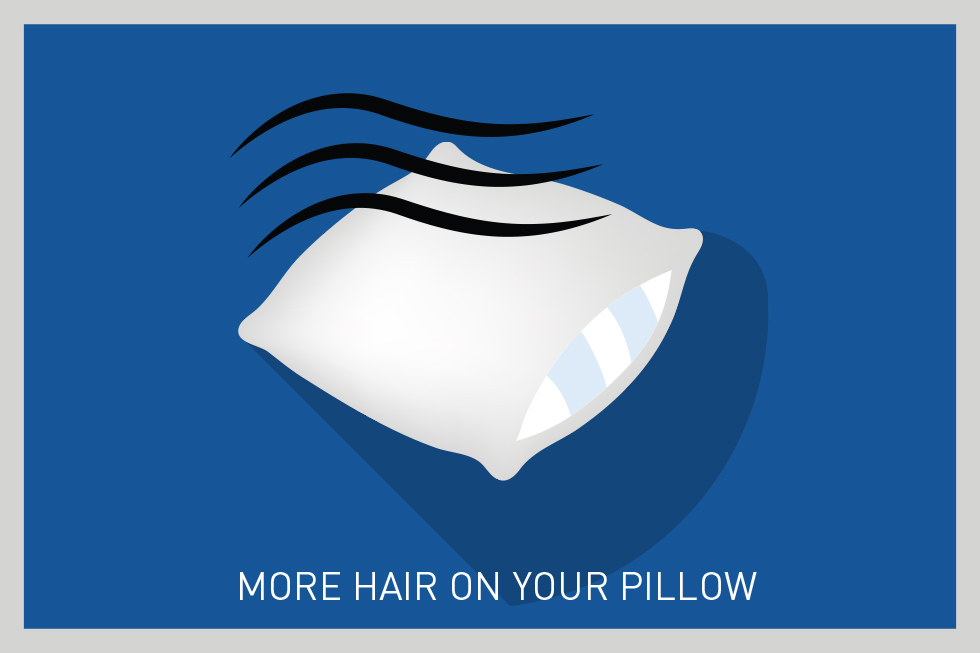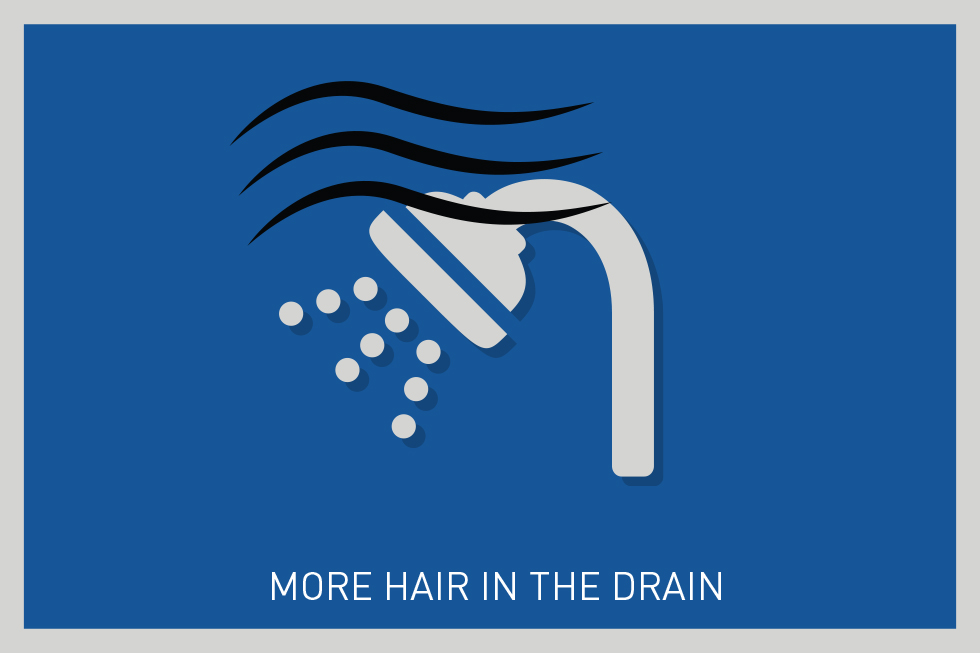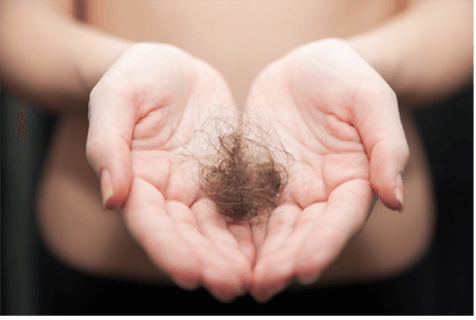Hereditary Hair Loss in Women
More than 1 in 3 women experience hair loss during their lifetime.
By 70 years of age, 38% of women have hereditary hair loss (or androgenetic alopecia). Androgenetic alopecia is a genetic condition, which reduces the amount of time that hair actively spends growing. Hereditary hair loss manifests itself in many different ways, but by far one of the most common symptoms is hair thinning. Distressing and upsetting for many sufferers, hair thinning is when the hair gradually becomes thinner over time, reducing the overall volume of your hair as it does.9,12,13,16,17,18
Signs of Female Hair Loss
Hair loss is common in women with 40% of women having visible hair loss by the time they are age 408. Hair loss may present in different ways depending on the cause. You may notice overall thinning, bald spots or sudden loss of handfuls of hair.
Below are some early signs that you may be experiencing if you have genetic or hereditary hair loss. If you notice any of these, REGAINE® for Men and Women Solution can help:

A receding hair line or widow’s peak
Hereditary hair loss typically begins with the receding of the hairline and the thinning of the hair.29 The best way to tell if you hair has receded is to find a picture of yourself from a year ago and make a comparison.

More hair on your pillow
We lose on average 30 to 150 hairs per day.30 If you see more than your usual amount of hair, this could be a sign of hereditary hair loss

More hair in your comb or brush
Having a few hairs in your comb or brush is normal. If you start to see more than usual this could be a sign of hereditary hair loss.

More hair in the shower drain
Having a large amount of hair in the drain after washing your hair is a sign that you are losing more hair than normal.
How can I tell if my hair is shedding more than normal?
It’s likely that if your hair is shedding more than normal, you’ve already noticed. Losing more hair in the shower? Are you finding more strands of hair on your hair brush?
While these signs of increased shedding could indicate a form of hair loss, the best way to know if you have female pattern hair loss is by looking at your pattern of hair loss and your family history.20 Does the hair on the top and crown of your head appear particularly sparse? Does your family have a history of hair loss? If so, it’s entirely possible you’re experiencing female pattern hair loss.
Note Your Family History for Hair Loss
Female pattern hair loss is genetic, so your first step should be to look to other family members to see if their hair has thinned. On the flipside, if you’re experiencing rapid hair loss and have no family history of hair loss, it would be best to check with your doctor to help understand what could be causing it.
Female Pattern Hair Loss Stages & Types

This diagram explains the stages of women’s hair loss. It is important to see your dermatologist for a correct diagnosis of your hair loss as soon as you notice your hair thinning. In fact the sooner you initiate your REGAINE® treatment, the more likely you will achieve the desired results.14
Woman with female pattern hair loss are less likely to go completely bald than men, but you may have a lot of thinning throughout your hair. Female pattern hair loss normally starts with a gradual thinning of the parting and can sometimes be accompanied by the loss of hair at the front of the scalp similar to male pattern hair loss.31If you are experiencing female pattern hair loss, you may still notice your hair growing. However, your follicles will continue to shrink, producing finer, shorter, and harder-to-see hair with each cycle until they are no longer able to make new hair.
Speaking To A Healthcare Professional About Women's Hair Loss
When consulting a healthcare professional about your hair loss, you may feel unsure on what to say. Below are some steps to take before and during your consultation to help you:

STEP 1: Create a simple diary to track your hair health
Jot down a list of out-of-the-ordinary experiences you have been having with your hair, such as more frequent and/or larger clumps of hair in the drain after showering, or an increased number of strands on your pillow. Take these daily observations over a 1- to 2-month time period. These are all things you want to mention to your healthcare professional.

STEP 2: Feel free to bring the evidence
Jot down a list of all the self-diagnostic tools and tests you’ve used and the results from these tests. Bring them with you to your appointment. You may also bring photos of your scalp. Some men bring in clumps of hair in a plastic bag for their healthcare professional to examine. Don’t be shy. He or she is there to help you.

STEP 3: Tell your healthcare professional about lifestyle habits or changes that may be related to hair loss
Although hair loss can be due to genetic factors, remember that there are still other causes of hair loss in women, such as long-term everyday stress and, in more rare cases, a medical condition (perhaps related to your thyroid)19.

STEP 4: Inquire if any further testing is necessary
Expect your healthcare professional to ask further questions and to do a detailed review of your medical history covering topics such as recent surgeries or cancer treatments (chemotherapy or radiotherapy), and familial history of hereditary androgenetic alopecia (e.g. genetic hair loss).
Female Pattern Hair Loss Facts

40% of women have visible hair loss by the time they are 40.8
Hereditary Hair Loss is the most common cause of hair loss in men and women.21
Female Pattern Hair loss can be identified by a prominent parting, more hair on the pillow, more hair in the drain and more strands on your comb/hairbrush.13
Women can inherit the hair loss gene from their mother, their father, or from both parents.23
On average, the female adult head has 100,000 individual strands of hair.16
Most people will shed between 30 and 150 hairs per day as part of a healthy re-growth cycle.30
Using REGAINE® for Women products can help stop or even reverse hereditary hair loss.4
References:
4. REGAINE® SPC – Section 5.1.
8. WebMD. (n.d.). Skin Problems And Treatments: Hair Loss Center. Retrieved September 7, 2012, from https://www.webmd.com/skin-problems-and-treatments/hair-loss/default.htm
9. Hadshiew IM, Foitzik K, Arck PC, Paus R. (2004). Burden of Hair Loss: Stress and the Underestimated Psychosocial Impact of Telogen Effluvium and Androgenetic Alopecia. Journal of Investigative Dermatology, 123 (3), 455-457.
12. Androgenetic Alopecia. (n.d.). Male and female pattern hair loss information. Retrieved May 7, 2020, from http://www.androgeneticalopecia.com/.
13. Bergfeld, W. F., & Mulinari-Brenner, F. (2001). Shedding: how to manage a common cause of hair loss. Cleveland Clinic journal of medicine, 68(3), 256–261.
14. Khandpur, S., Suman, M., & Reddy, B. S. (2002). Comparative efficacy of various treatment regimens for androgenetic alopecia in men. The Journal of dermatology, 29(8), 489–498.
16. Shapiro J. (2007). Clinical practice. Hair loss in women. The New England journal of medicine, 357(16), 1620–1630.
17. Ramos, P. M., & Miot, H. A. (2015). Female Pattern Hair Loss: a clinical and pathophysiological review. Anais brasileiros de dermatologia, 90(4), 529–543.
18. Mayo Clinic. (n.d.). Hair loss: Symptoms & Causes. Retrieved May 7, 2020, from https://www.mayoclinic.org/diseases-conditions/hair-loss/symptoms-causes/syc-20372926.
19. American Hair Loss Association. (n.d.) Women’s Hair Loss: Diagnosis. Retrieved May 7, 2020, from https://www.americanhairloss.org/women_hair_loss/diagnosis.html.
20. American Hair Loss Association. (n.d.). Women’s Hair Loss: Causes of Hair Loss. Retrieved May 7, 2020, from https://www.americanhairloss.org/women_hair_loss/causes_of_hair_loss.html.
21. Jacobs, J. P., Szpunar, C. A., & Warner, M. L. (1993). Use of topical minoxidil therapy for androgenetic alopecia in women. International journal of dermatology, 32(10), 758–762.
23. Drugs.com. (n.d.). Hereditary-Pattern Baldness. Retrieved March 16, 2020, from http://www.drugs.com/health-guide/hereditary-patterned-baldness.html.
29. Blumeyer, A., Tosti, A., Messenger, A., Reygagne, P., Del Marmol, V., Spuls, P. I., Trakatelli, M., Finner, A., Kiesewetter, F., Trüeb, R., Rzany, B., Blume-Peytavi, U., & European Dermatology Forum (EDF) (2011). Evidence-based (S3) guideline for the treatment of androgenetic alopecia in women and in men. Journal der Deutschen Dermatologischen Gesellschaft = Journal of the German Society of Dermatology: JDDG, 9 Suppl 6, S1–S57.
30. British Association of Dermatologists. (n.d.). Telogen effluvium. Retrieved October 26, 2020, from https://www.bad.org.uk/ResourceListing_NonResponsive.aspx?sitesectionid=2&id=412&showmore=1&returnlink=http%3A%2F%2Fwww.bad.org.uk%2FResourceListing_NonResponsive.aspx%3Fsitesectionid%3D159%26sitesectiontitle%3DPatient%2BInformation%2BLeaflets%2B(PILs)%26originalpath%3Dfor-the-public%252fpatient-information-leaflets#.X5aIP4gzZPY.
31. Dinh, Q. Q., & Sinclair, R. (2007). Female pattern hair loss: current treatment concepts. Clinical interventions in aging, 2(2), 189–199.

